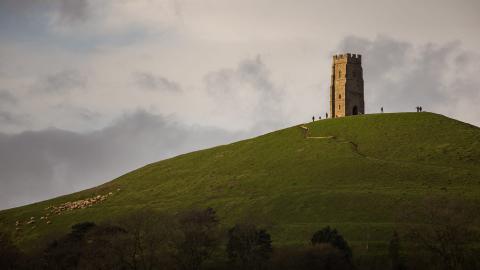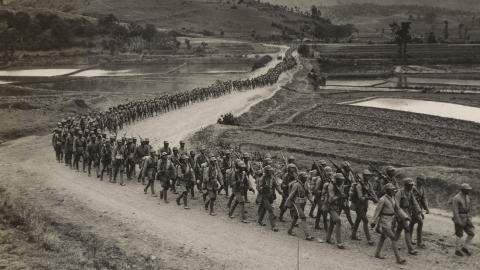
U-Boat Wargamers tells the story of the Women's Royal Naval Service (WRNS) who helped take down Germany's fearsome U-Boats.
1918
Future Grand Admiral Dönitz’s U-Boat is sunk off Malta and he is captured by the British. He is sent to Manchester where he appears to be mad (although some observers think his madness is fake) and transferred to Manchester Lunatic Asylum.
In the asylum, Captain Dönitz devises the ‘Wolf Pack’ tactics which he will use during World War II, where one U-Boat, spread out in a long line of U-Boats, radios the rest of the pack to converge on a convoy.
1918
Also in 1918, in the UK, Vera Laughton Matthews is selling copies of The Suffragette. A committed feminist, she had served in the Women’s Royal Naval Service (WRENS) in World War I until it was wound up in November 1918. Eventually she and Dönitz, through the group of women she recruits to the WRENS, will go head-to-head in World War II. In the 1930s she sets up a women’s branch of the Sea Rangers so that the WRENS can be revived at short notice if there is a war.
1935
Commander Gilbert Roberts leads board game-style wargaming exercises at Portsmouth. He suggests to Royal Navy admirals that he ought to factor in Germany attacking British shipping using U-Boats. The admirals tell him that the Germans would never do that, and he is told not to assume this in his wargames.
1938
Commander Gilbert Roberts gets TB and is retired from the Navy as medically unfit. He ends up, at the start of the war, fronting a Home Guard unit in Portsmouth.
1939
Dönitz is put in charge of Germany’s submarine fleet. The Royal Navy is complacent about its ability to sink submarines due to its confidence in its ASDIC detection system. This encouraged the Admiralty to suppose it could deal with submarines whatever strategy they adopted. They were proven wrong as submarines were difficult to locate and destroy under operational conditions.
1939
War is declared between Britain and Germany. At the very start, on 23 September 1939, Hitler approves the strategy that all Allied merchant ships making use of their wireless should be stopped by U-Boats and sunk or captured. The Allies had not foreseen this.
In May 1940, 101 allied ships are sunk, followed by 140 in June, 53 of them in the Atlantic. Dönitz loses just fifteen U-Boats in the first six months of 1940.
1939
The WRENS are re-formed with Vera Laughton Matthews in charge as Director. Although the Royal Navy sees the role of the WRENS as typists and car drivers, Vera doesn’t recruit typists and car drivers. She starts to recruit women with high skill levels and achievements, such as mathematicians and sporting stars. She does this because she knows that the Navy will eventually run out of men to occupy its top ranks.
1940 – 1942
Dönitz gets a competition going between his submarine aces to determine who can sink the greatest tonnage of Allied vessels. For a victim’s tonnage to count, that ship must go to the bottom of the sea.
In October 1940, the slow convoy SC 7, with an escort of two sloops and two corvettes, is overwhelmed, losing 59% of its ships. The battle for convoy HX 79 in the following days is in many ways worse for the escorts. The loss of a quarter of the convoy without any loss to the U-Boats, despite a very strong escort (two destroyers, four corvettes, three trawlers, and a minesweeper) demonstrates the effectiveness of the German tactics.
As Allied losses continue to mount, Churchill becomes more and more concerned, saying in his memoirs that 'the only thing which kept me awake at night was the convoy losses'. Without the food coming across the Atlantic, Britain would starve, and there would be no prospect of launching an invasion of occupied Europe.
And yet, the Navy does not understand the highly effective tactics that the U-Boats are using, which often result in a U-Boat sinking as many ships as it has torpedoes. Captain Johnnie Walker, a British escort commander, seems to have found the answer when he invents the tactic ‘Buttercup’ (named after his wife). This involves the escort ships moving outside the convoy and firing flares whenever a U-Boat is spotted. But some Naval experts are sceptical.
1 January 1942
A black car pulls up outside Gilbert Roberts’ lodgings in Portsmouth on 1 January 1942 and takes him at speed to 10 Downing Street, where he is confronted by Churchill. This is a bit of a shock for Roberts. Churchill has heard of Roberts’ skill at wargaming and simply says to him:
‘Find out what the U-Boats are doing and sink them.’
That night Roberts is sent on the train to Liverpool to Western Command to meet the admiral in charge. Roberts asks for mathematicians and gaming specialists so that he can set up a wargaming room in the bomb-damaged attic at the top of the building. But the Admiral says: 'We have no men to spare.'
This is the moment for which Vera Laughton Matthews has been waiting.
February 1942
Gilbert Roberts and Vera Laughton Matthews sit down to recruit a wargaming team from the Women’s Royal Naval Reserve. The first recruit to Roberts’ team is the first woman to qualify as a Chartered Accountant in the UK, Jean Laidlaw. 66 other women follow.
They immediately set to work analysing both Buttercup and what the U-Boats are doing, using models and string.
The first question Roberts asks is 'What is the range of a U-Boat torpedo?' He must ring Britain’s greatest World War I submariner, Admiral Horton, to find out.
Horton tells him it is about one mile. Jean Laidlaw spots that the U-Boats cannot be outside the convoy with a weapon of that kind and be that accurate, as the convoys are miles across. Therefore, the U-Boats must be inside the convoys. How are they getting there?
They work late into the night. Jean Laidlaw notices that, while a U-Boat is slow when submerged, it is fast on the surface of the water; about seventeen knots. Could it be that the U-Boats are getting into the middle of the convoys at night on the surface, and then attacking ships in the convoy at point-blank range?
But that doesn’t solve the question of how the U-Boats escape undetected from the convoy.
Laidlaw then sees what the U-Boats are doing. Having shot their torpedoes they submerge to their maximum depth, 720 feet, which is well beyond the range of ASDIC, and let the convoy pass over them. Then they resurface behind the convoy, away from the Navy’s escorts.
Laidlaw also realises that any success with Buttercup is a fluke; it encountered a couple of U-Boats going into the convoy but could not predict where they would be. What they need is a tactic that sends the escort vessels to the rear of the convoy and intercepts the U-Boats as they surface.
The new tactic is named by Jean Laidlaw as ‘Raspberry’, as in blowing a raspberry at Hitler.
May 1943
The new wargaming unit is named WATU (Western Approaches Tactical Unit). Throughout 1942 and 1943, it devises many new tactics to sink the U-Boats, based on the different types of attack and the escape route they use.
All these tactics come together in a battle that rages, in May 1943, around Convoy ONS 5. This is a decisive turning point in the Battle of the Atlantic and is a complete vindication of the WATU tactics. Strangely, this battle has no name (other than ONS 5) in British naval history, but the Germans have given it a name: Die Katastrophe von ONS 5.
Convoy ONS 5 consists of 43 ships bound from Liverpool to Halifax, Nova Scotia. During a battle that lasts for just over a week in early May, Dönitz tries to get his U-Boat wolf packs into the middle of the convoy but is constantly frustrated by the Allies’ escorts. The Allies, using WATU’s tactics, accurately depth charge his submarines. Although by the end of the engagement, Dönitz has sunk thirteen ships, he has also lost fourteen U-Boats. That rate of loss, as Hitler points out to him, is unsustainable.
In late May 1943, Dönitz withdraws his U-Boats from the Atlantic. Although he threw them into several suicide attacks during D-Day in June 1945, they were never a significant force again.
1942 – 1945
WATU is used to train captains of Allied ships in anti-U-Boat tactics, including the late Duke of Edinburgh while he was a naval lieutenant. Gilbert Roberts always starts the wargames by saying: 'Make your mistakes here, not at sea.'
The captains playing the wargames are assisted by the WRENS, who provide tactical advice. Several of the WRENS go on to marry officers they meet during the wargames.
May 1945
Interestingly the British did not keep the existence of WATU a secret during the war. A journalist visits WATU in January 1944 to observe a wargame and publishes a short article in The Daily Herald. A larger exposé appears in Illustrated magazine the following month.
By then WATU had devised the winning tactics in the Battle of the Atlantic. It appears that the Royal Navy was keen to demonstrate to the Germans that they had not lost that battle due to superior Allied technology, but because they had been outplayed tactically. The Navy did not wish the Germans to create a history of technological victimhood. They had lost because they had been out-thought and out-played. That was a legacy and weakness of Nazism.
As part of this, Gilbert Roberts was sent to the seat of the new German government in Flensburg in May 1945. There he had a brief encounter with Karl Dönitz, whom Hitler had appointed his successor. Dönitz claimed he was busy and had urgent business, so they did little more than acknowledge each other. In reality, Dönitz had just been arrested for war crimes and was being sent to jail.
Roberts wondered if Dönitz knew who he was. When he entered the office of Dönitz’s deputy, he saw a picture of himself, taken from the piece in Illustrated magazine about WATU, with the legend underneath in German: 'This is Gilbert Roberts. This is your enemy.' Dönitz knew full well who Roberts was.
Legacy
What makes WATU remarkable in the history of military wargaming is not only that, for the first time, it was operated by the WRENS, but also that it was the first instance where wargames were used to develop solutions on the fly to problems that were happening in a real war. Up to that point, most wargames were played during peacetime to prepare officers for potential wars.
At the end of the war, and the closing of WATU, Admiral Noble sent Gilbert Roberts a letter that said: 'You had a great deal to do in winning the war because if we hadn’t won the Battle of the Atlantic, we should undoubtedly have lost the war!'
Although WATU disappeared it was the important ancestor of a long tradition of naval wargaming which continues to this day.
But the strangest story is that of the WRENS, who devised the tactics which defeated the U-Boats. After the war they all rigorously observed the Official Secrets Act and kept silent about what they had been doing during the war. Vice-Admiral Michael Gretton, the son of Judy du Vivier, says that his mother never told him what she did in the war, even though he became a senior Navy officer.
Unlike the women of Bletchley Park, their outstanding achievements were forgotten. It could be that the article written in 1945 was widely disbelieved, or just lost in the chaos of victory.
Jean Laidlaw quietly returned to civilian life and worked as an accountant. She moved in with her girlfriend after the war and passed away in the early 2000s.























